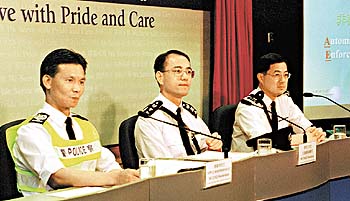Nowhere to run for traffic offenders
 CSP T William Tang briefs the media on the new system |
Traffic offenders detected by automatic enforcement cameras can be nabbed in no time thanks to a new $6 million computer system launched on March 12.
The Automated Non-Stopper Traffic Enforcement Computer System (ANTECS) automatically identifies vehicle number plates in photos taken by Speed Enforcement Cameras (SEC) and Red Light Cameras (RLC) and analyses speed and other related factors.
It obtains information on the car owner from the Transport Department's computer system and generates forms for driver identification. Preparation of Fixed Penalty Tickets and summons applications are also automated. Plus, a link with the Judiciary's computer system collected court verdicts for statistical study. First developed in July last year, the system was stringently tested in February before introduction.
Chief Superintendent (Traffic) William Tang How-kong said the system would improve efficiency in handling traffic offences, particularly with our increasing arsenal of SECs and RLCs.
"Processing time will be saved by about 30 per cent with this system and officers will be able to concentrate more on other work," Mr Tang said. Central Traffic Prosecution Bureau Superintendent Denys Chan Wing-hong said: "It could take up to 10 days to handle non-stop traffic offences before. But with this new system, the processing time will decrease to one to three days."
Meanwhile, a prototype camera/computer system that gives sharp, colour photos of offending vehicles, even at night, was set to be delivered to Traffic Branch Headquarters for testing. The system takes on improvements garnered from feedback attained during testing of a similar one in each land Region over the last year.
It featured a target range of up to 120 metres, could store up to 10,000 high-quality pictures for court evidence, and an infra-red camera ensured good visibility at night.
TBHQ Chief Inspector (Administration and Support) Joe Kong Kai-cho said: "We will test the prototype and if it meets our requirements we will consider whether to buy more. It is our long-term goal to use more imaging equipment as it gives us more reliable and convenient evidence to use in court. It also saves officers a lot of time and frees them up for other duties."